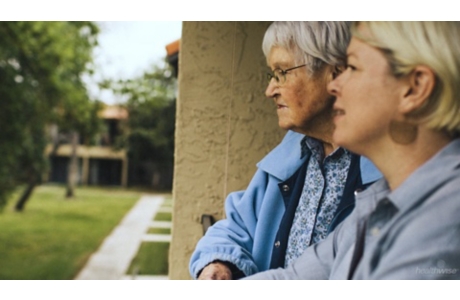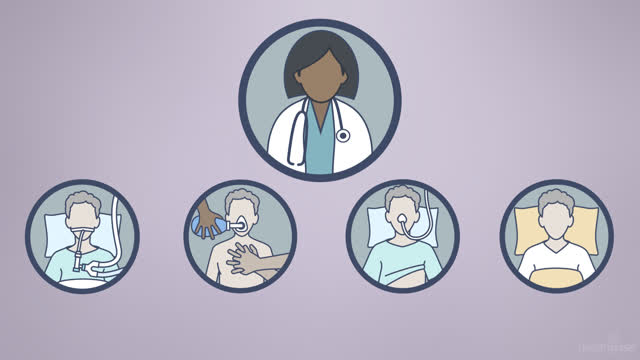Hospice Care
Topic Overview
“When my doctor told me my cancer couldn’t be cured and I probably had 6 months at best, it was hard to believe I’d run out of options. But then I started hospice care, and it’s helped me face my fears. And I’m making decisions about how I want to go out and what will happen afterwards. It’s given me back at least a little feeling of control.”—Avery, 81
“My hospice care nurses have encouraged me to try to make the most of every day. I say ‘I love you’ a lot more, and I try to be honest about my feelings, to myself and to others. I’m so grateful for my hospice team. They are a blessing.”—Barbara, 68
What is hospice care?
Hospice care provides medical services, emotional support, and spiritual resources for people who are in the last stages of a serious illness, such as cancer or heart failure. Hospice care also helps family members manage the practical details and emotional challenges of caring for a dying loved one.
The goal is to keep you comfortable and improve your quality of life.
Hospice programs offer services in your own home or in a hospice center. Some hospices also offer services in nursing homes, long-term care facilities, or hospitals.
Some people think that starting hospice is a last resort, that it means they’re giving up on life. Some think that hospice means a lower level of medical care. But hospice is simply a type of care that focuses on the quality of your life instead of on continuing with treatment to prolong your life.
Why choose hospice care?
During the often difficult last stages of a serious illness, many people feel that they have lost control over their lives and over what will happen to them.
Hospice care can show you your options. And knowing your options gives you back some control. It allows you to make decisions about things that are important to you.
What kind of services are provided?
Hospice services usually include:
- Basic medical care with a focus on pain and symptom control.
- Access to a member of your hospice team 24 hours a day, 7 days a week.
- Medical supplies and equipment as needed.
- Counseling and social support to help you and your family with psychological, emotional, and spiritual issues.
- Guidance with the difficult, but normal, issues of life completion and closure.
- A break (respite care) for caregivers, family, and others who regularly care for you.
- Volunteer support, such as preparing meals and running errands.
- Counseling and support for your loved ones after you die.
Who is involved with hospice?
Most of the time, hospice care is provided in your home. Family members or loved ones may look after you much of the time. The hospice team will work with them to give you the best care possible. Someone from your hospice team will likely visit you for an hour or so once a week or more.
In addition to a doctor and nurses, hospice teams usually include:
- Social workers.
- Medicine specialists.
- Spiritual advisers.
- Nursing assistants.
- Trained volunteers.
Some hospice teams also include:
- Pharmacists.
- Respiratory therapists.
- Psychologists.
- Psychiatrists.
- Music therapists.
- Physical therapists.
- Occupational therapists.
Some people worry about losing touch with their regular, trusted doctor. But he or she can work with others on your team to stay involved in your care.
Are you eligible for hospice services?
Usually, these two things must be true for you to be eligible for hospice care:
- Your condition cannot be cured. This is called a terminal illness.
- Your doctor expects that you will live 6 months or less if your illness runs its normal course.
Some people live longer than expected. If you live longer than 6 months, you can continue with hospice care. If your illness gets better, you can stop getting hospice care. You may no longer qualify for it.
Hospice care is generally paid for by Medicare, Medicaid, and private insurance. Care may also be available to those unable to pay.
Considering Hospice Care
The last stages of a serious illness can be so hard. You may feel like you have lost control over your life and what will happen to you.
Hospice can help you get back some control by showing you what your options are and helping you make decisions about things that are important to you.
You may want to consider hospice care if:
- You have a disease or illness that is expected to shorten your life.
- Treatment that tries to cure the disease or prolong your life has become more of a burden than a benefit to you.
- You would like to spend your remaining life as comfortably as possible in a setting that you choose, such as your own home.
- You want family and friends to participate in your care.
- You want your loved one who has a serious illness to die comfortably at home.
Some people who might benefit from hospice care don’t receive it. Many people, including some health professionals, simply don’t know much about it. It can be hard for a doctor to talk to a patient about hospice, because it means talking about the end of life.
It can also be hard for you and your family to accept that the end of life is near. Some families choose to pursue aggressive medical care up to the end.
Who is eligible
Eligibility for most hospice programs is usually based on two main requirements:
- Your illness can’t be cured. This is called a terminal illness.
- Your doctor expects that you will live 6 months or less if your illness runs its normal course. Typically a form must be signed by your primary doctor as well as the medical director or physician member of a hospice team.
It can be hard for doctors to know how long a person will live. Some people live longer than expected. If you do live longer than 6 months, you can continue with hospice. If your illness gets better, you can stop receiving hospice care. You may no longer qualify for it.
Hospice care is generally paid for by Medicare, Medicaid, and private insurance. Care may also be available to those unable to pay.
Hospice care for special situations
Some people are living with a terminal illness that is not predictable. They may not necessarily die within 6 months. In fact, they may live for several years. But they may still be eligible for hospice care.
There are guidelines for terminal diseases that have an unpredictable course. People who have the following illnesses may have hospice care when their disease has reached an advanced stage:
- Cancer.
- AIDS.
- ALS.
- Emphysema.
- Heart failure.
- Kidney disease.
- Alzheimer’s disease.
Many people who are living with a disease that has an unpredictable but still terminal course may also want and be able to receive hospice care. In some of these cases, Medicare might not cover hospice care costs. Medicare covers the cost of hospice in the last 6 months of life.
How to talk to your family and medical team
If you feel that you need to ask questions and explore your options about end-of-life care, including hospice, don’t wait for your doctor or loved ones to bring up the subject. Be open and direct with your loved ones and your health professionals.
Your doctor can go over hospice care and other options with you. He or she can explain the pros and cons of each of them, answer questions, and advise you. Then you can think about the kinds of treatments you would or would not want in different situations. This can help you get a clear idea of your wishes.
You can make many choices about your end-of-life care ahead of time. Making plans while you are still able may ease your mind and make your final days more peaceful.
Write down any questions you have about hospice care to discuss with your doctor during your next visit. Let your family and doctor know what you decide so they can help carry out your wishes.
The goals of hospice
One goal of hospice is to allow you to live out your life without further treatment for your illness, as naturally as possible. You’ll get medical care to provide comfort rather than to prolong life.
For example, chemotherapy may no longer be used to cure your cancer, but it may be given to reduce pain.
People who want to live as long as possible by any medical means are not a good match for hospice care.
Another goal of hospice is to give you as much control and dignity as possible during the time you have left. For example, most people in hospice can choose to die at home, surrounded by loved ones, rather than in a hospital, hooked up to one or more machines.
Other medical care is always available
It’s important to understand that hospice doesn’t include treatment to cure your illness. But your hospice team will prepare your caregivers to cope with almost anything that could happen at home.
And being in hospice care doesn’t mean that you can’t go to a hospital if you need to. When a hospice takes over your care, they will work with you to arrange for any medical care that you need. If something happens that causes a caregiver to call 911, you may be treated in a hospital and later return to hospice care.
Receiving Hospice Care
When you decide to be cared for by a hospice program, it means that your treatment goals will shift from doing everything possible to cure your condition to giving you the best quality of life that is possible in the time you have left.
You don’t need to be bedridden or in a hospital to benefit from hospice care. No matter what your physical condition, hospice services focus on keeping you as comfortable, functional, and alert as possible.
Hospice services
Your hospice team may include medical professionals, counselors, therapists, social workers, spiritual advisers, home health aides, and trained volunteers. Your team can:
- Help with advance directive forms and making sure that your wishes about life support and CPR (cardiopulmonary resuscitation) are carried out.
- Answer questions about palliative treatments, which relieve pain and other symptoms.
- Help you with things like daily activities, bathing, eating, and moving around.
- Help you figure out what is important in terms of putting your legal and financial affairs in order.
- Help you and your family talk to each other and deal with difficult emotions.
- Give your caregivers a break (respite care). Trained volunteers may be available to relieve your loved ones for a few hours a week. If your caregivers need a longer break or must be away to attend a special event, some hospices provide respite care for several days.
Counseling and support
Counseling and support services that hospice provides can help you to:
- Resolve differences with family and friends or say important things that may otherwise go unsaid.
- Review your life and set goals for the time you have left.
- Explore spiritual issues.
Hospice care also includes helping your family and friends through their grief after you die. Most programs continue to provide bereavement services for family and friends, such as support groups and counseling, for at least a year after a loved one’s death.
Arranging for Hospice Care
If you decide that you want hospice care, you’ll need to complete documents to determine your eligibility and insurance coverage and to outline your treatment preferences. These documents include:
- Health care agent or medical power of attorney. For more information, see the topic Choosing a Health Care Agent.
- Living will. For more information, see the topic Writing an Advance Directive.
- Insurance forms. Hospice services are covered by Medicare, by Medicaid in most states, and by many private insurance plans. Check with your employer or your health insurance plan for information about what services your plan covers. Many hospices will also help people who cannot pay.
- Other legal documents related to finances, property, and other matters.
Choosing a hospice program
Your doctor or a member of your health care team may refer you to a hospice program. If not, you may want to ask your doctor to do so.
Or you may choose a hospice program yourself. Start by calling some of the programs in your area. People and organizations that can help you find hospice programs include:
- Your doctor or hospital.
- The medical social worker at your hospital or nursing home.
- Your state or local agency on aging.
- Your state health department.
- Your insurance provider.
- The phone book. (Look in the yellow pages under “home care” or “hospice.”)
- Your state hospice organization.
- National organizations such as the National Association for Home Care, the National Hospice and Palliative Care Organization, and the Hospice Association of America. For contact information, see the Other Places to Get Help section of this topic.
A checklist( What is a PDF document? ) can be helpful when you are choosing a hospice program. This checklist has questions you can ask to compare the hospice programs in your area.
All hospice programs should provide written materials that describe their services, including who provides the services, who is eligible, costs and payment processes, and the program’s insurance and liability information. Ask for this information, and read it carefully.
Staying organized
After you have begun the hospice program, you will want to get all billing arrangements in writing, including costs and payment arrangements. Be sure to keep a copy.
Be sure that your family knows:
- What services you are to receive from the program.
- What the schedule is.
- The names and phone numbers of important contact people at the hospice. Post this information near your telephone.
It’s also important to make sure that your family will get the support they need after you die. Choose one person to be responsible for notifying family and friends about support group meetings, bereavement counseling opportunities, and other services that the hospice program may provide.
References
Other Works Consulted
- Emanuel EJ (2015). Palliative and end-of-life care. In DL Kasper et al., eds., Harrison’s Principles of Internal Medicine, 19th ed., vol. 1, pp. 55–70. New York: McGraw-Hill Education.
- Rakel RE, Strauch EM (2011). Care of the dying patient. In RE Rakel, DP Rakel, eds., Textbook of Family Medicine, 8th ed., pp. 53–72. Philadelphia: Saunders.
- Zisook S, et al. (2009). Death, dying, and bereavement. In BJ Sadock, VA Sadock, eds., Kaplan and Sadock’s Comprehensive Textbook of Psychiatry, 9th ed., vol. 2, pp. 2378-2407. Philadelphia: Lippincott Williams and Wilkins.
Current as of: April 1, 2019
Author: Healthwise Staff
Medical Review:E. Gregory Thompson, MD – Internal Medicine & Adam Husney, MD – Family Medicine & Kathleen Romito, MD – Family Medicine
This information does not replace the advice of a doctor. Healthwise, Incorporated, disclaims any warranty or liability for your use of this information. Your use of this information means that you agree to the Terms of Use. Learn <a data-articleid=”support-abouthw” data-document-href=”support-abouthw” data-document-type=”Support” data-hwid=”support-abouthw” data-section-href=”support-abouthw-editorial” data-topicid=”support-abouthw-edi






